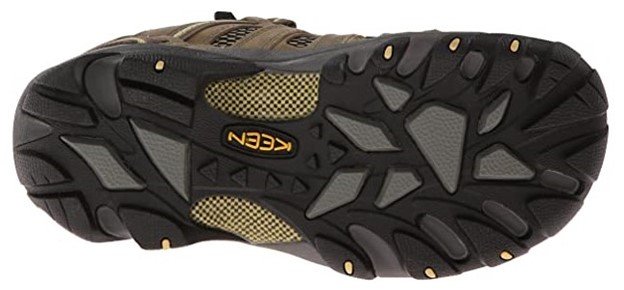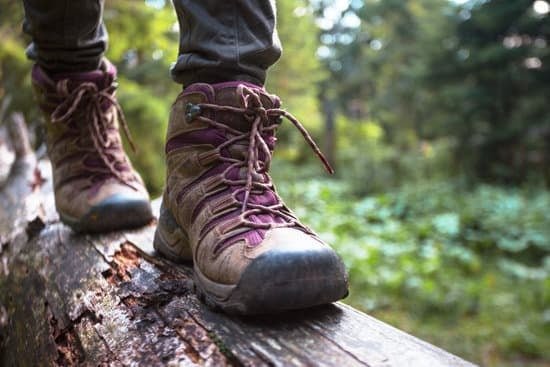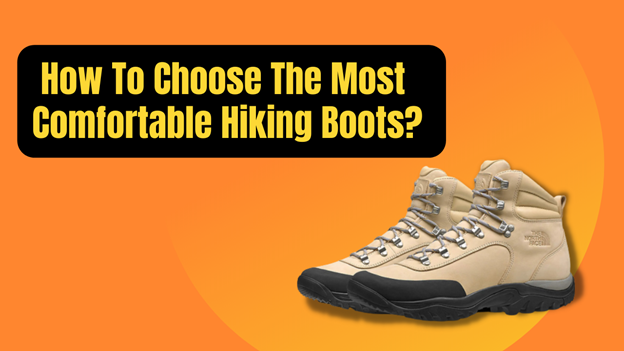Finding The Most Comfortable Waterproof Hiking Boots?
There’s nothing worse than being on a long hike and having blisters on your feet from ill-fitting shoes. That’s why it is important to choose the most comfortable hiking boots for your next adventure. This article will show you how to find the best breathable hiking boots for men and the best hiking boots for women that will keep you blister-free and comfortable all day long.
What To Consider When Buying The Perfect Lightweight Breathable Hiking Boots?
1) Upper Material:
When choosing your hiking boots, it’s important to consider the type of upper materials from which they are made. Some popular options include full-grain leather, split-grain leather, nubuck leather, synthetics, waterproof membranes, and vegan materials. Each of these has its own benefits and drawbacks, so it’s important to choose a material that is best suited to your needs.
2) Outsole (Rubber or synthetic):

When it comes to the outsole, you’ll need to decide between rubber and synthetic materials. Rubber outsoles provide great traction on different types of terrain but can be more expensive and difficult to maintain over time. On the other hand, synthetic outsoles are often cheaper and easier to care for but may not provide as much traction in certain situations.
3) Midsole (EVA foam, PU foam, shank):
The midsole of your hiking boots is important for cushioning and support. Some popular options include EVA foam, PU foam, and shank. EVA foam is lightweight and durable, while PU foam provides some extra cushioning and shock absorption. Shank can help support your foot arch but may make your hiking boots slightly heavier.
4) Lining (Moisture wicking or waterproof):
The lining of your hiking boots plays a key role in keeping you comfortable for longer periods of time. Some popular lining options include moisture-wicking and waterproof materials. Moisture-wicking linings help pull sweat away from your feet and keep them dry, while waterproof linings help prevent water from seeping in and causing blisters or discomfort.
5) Insole:
The insole is what provides cushioning and support under your feet. Most hiking boots come with removable insoles so that you can customize the fit and level of comfort. If you have high arches, then look for an insole that provides extra support in that area. Some insoles are made with special materials that help wick away sweat and keep your feet dry during long hikes.
6) Water-Resistant
Another important feature to look for in any type of hiking boot is the waterproof protection. While this might not matter if you’re only planning to use them during dry weather, it’s essential if you’ll be walking through wet or snowy conditions. Thankfully, most boots these days come with some level of water-repellent coating or membrane lining that helps keep your feet dry.
7) Ankle Support:
If you are hiking on rough trails with a heavy backpack, then you’ll want to look for boots that offer good ankle support. This will help reduce the risk of sprains and other injuries while also preventing soreness and fatigue in your lower legs. Look for boots with stiffer materials or deep lugs on the bottom for better stability when walking uphill.
8) Comfort And Fit:
Comfort is key when it comes to choosing any type of footwear, including hiking boots. You’ll want to find a pair that fits well around your foot and provides enough cushioning to wear them all day without discomfort. Many brands now sell hiking boots with different widths and arch support options to ensure that you get a perfect fit.
9) Size:
Always buy hiking boots in the correct size for your feet. If you’re going to wear thick socks with them, make sure to purchase the size that will accommodate those. Otherwise, you’ll risk cuts and blisters from ill-fitting shoes that are too small or large.
10) Weight:
Another thing to consider when choosing hiking boots is the weight. Heavier leather options will be more durable but can cause fatigue if you carry them long distances. On the other hand, lighter synthetic materials might not last as long but won’t weigh you down as much on the trail.
11) Break-In Period:
No matter what type of hiking boot you choose, it’s always going to need a break-in period before it’s truly comfortable. Plan to wear them around the house or on shorter hikes before committing to a long backpacking trip. This will give your feet time to adjust to the new shoes and prevent any painful blisters from forming.
12) Price:
Finally, don’t forget to consider the price when choosing hiking boots. While you might be tempted to go for the cheapest option, remember that this could end up costing you more in the long run if they fall apart quickly or cause injuries due to poor construction. It’s better to invest in a quality pair of boots that will last you for years of adventures.

FAQs:
Are hiking boots the same for women and men?
There is no real difference between men’s and women’s hiking boots. However, some brands may offer a wider or narrower fit for each gender, so you should always check the size chart before purchasing. Additionally, women might prefer boots with slightly shorter shafts to accommodate their shorter legs. And finally, if you have wide feet, you might want to look for men’s boots since they tend to be wider than women’s.
Do I need to buy a separate pair of shoes for hiking?
You don’t necessarily need to buy a separate pair of shoes specifically for hiking. However, it is recommended that you wear shoes with good traction and support when hiking on rough or slippery trails. This helps reduce the risk of injury and makes your hike more enjoyable overall. Additionally, many people prefer the extra protection that hiking boots provide against elements like rocks and roots.
Do I need to wear socks with my hiking boots?
You should always wear socks with your hiking boots to prevent blisters and excessive rubbing. If you are hiking in cold weather, you might want to invest in a pair of wool socks that will help keep your feet warm. And if you’re hiking in hot weather, choose a lightweight material that will wick away sweat.
What are the best hiking boots for beginners?
There is no one-size-fits-all answer to this question since everyone’s feet are different. However, we would recommend starting with a mid-weight boot that is comfortable and has good traction. Once you’ve been hiking for a while, you can then experiment with different styles and materials to find what works best for you.
Do I need to waterproof my hiking boots?
If you’re hiking in wet or muddy conditions, it’s good to waterproof your boots. This will help keep your feet dry and comfortable and prevent the boots from getting ruined. There are many different ways to waterproof boots, so be sure to read the instructions carefully before applying any products.
How do I take care of my hiking boots?
Taking care of your hiking boots is important if you want them to last for years. Be sure to clean them after each hike, and then store them in a cool, dry place. You might also want to apply a waterproofing treatment from time to time, depending on how often you use them. Additionally, it’s good to get your boots professionally cleaned and serviced every few years to keep them in top condition.
6 Tips and Advice to Buy Hiking Boots Online:

In today’s digital age, shopping for hiking boots online has become increasingly popular. With numerous brands and models available at the click of a button, it’s convenient and offers a wider selection than ever before. However, purchasing hiking boots online can be a daunting task, as you’re unable to try them on or assess their quality in person. To help you make an informed decision, here’s a recap of essential tips and advice to consider when buying hiking boots online.
- Research, Research, Research: Before making any purchase, thorough research is crucial. Take the time to familiarize yourself with different brands, models, and their specific features. Read reviews from reputable sources and consider user feedback to gain insights into the boots’ durability, comfort, and performance.
- Know Your Hiking Style and Terrain: Understanding your hiking preferences and the terrain you’ll be traversing is vital. Are you an occasional hiker, a seasoned adventurer, or something in between? Determine if you need boots for day hikes, backpacking trips, or rugged mountain expeditions. Consider the terrain, such as rocky trails, muddy paths, or snowy conditions, to ensure you choose boots that can handle the challenges you’ll encounter.
- Take Accurate Measurements: One of the biggest challenges of online boot shopping is getting the right fit. Measure your foot accurately by following the brand’s sizing guidelines. Consider using a measuring tape and consult size conversion charts if needed. Remember that some brands may have variations in sizing, so it’s essential to read customer reviews regarding the fit of specific models.
- Consider Comfort and Support: Comfort and support are paramount when selecting hiking boots. Look for features like cushioning, arch support, and shock absorption. Consider the materials used in the boot’s construction, as they can affect breathability and flexibility. Pay attention to details such as ankle support, lacing systems, and insoles to ensure a comfortable fit for long hikes.
- Look for Quality and Durability: Hiking boots need to withstand the rigors of the trail, so prioritize quality and durability. Pay attention to the materials used, such as sturdy leather or durable synthetic fabrics. Look for reinforced toe caps and heels, as they offer added protection and longevity. Additionally, examine the outsoles for reliable traction and grip on various surfaces.
- Check Return and Exchange Policies: Before making a purchase, thoroughly review the return and exchange policies of the online retailer. In case the boots don’t fit or meet your expectations, it’s crucial to have the option to return or exchange them hassle-free. Look for free returns or exchanges and ensure you understand the time limits and any associated costs.
By following these tips and advice, you can confidently navigate the online landscape and find the perfect pair of hiking boots for your next adventure. Remember, thorough research, accurate measurements, and considering your specific needs are key to making an informed choice. Lace up your new boots and embark on unforgettable hikes with confidence and comfort.
Conclusion
It can be tough to find the perfect hiking boots, but with this information, you’ll be able to select the most comfortable and durable pair for your next outdoor excursion. We’ve included a variety of tips on different factors you should consider when making your purchase.
So, whether you’re a beginner hiker or an experienced outdoors person, we have all the information you need to make a wise choice and hit the trails in style! Have you found the perfect pair of hiking boots yet? If not, you can check my “6 Cute Women Hiking Boots For a Successful Hike” and the “6 Best Waterproof Men Hiking Boots” get ready to explore nature like never before. But for now..Be Safe And Happy Hiking.!

